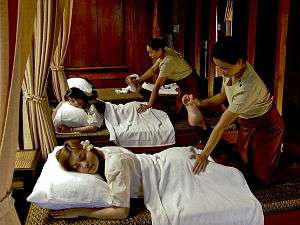Thai massage

| This article is part of a series on |
| Fringe medicine and medical conspiracy theories |
|---|
 |
|
General information |
|
"Thai massage" or "Thai yoga massage" is an ancient healing system combining acupressure, Indian Ayurvedic principles, and assisted yoga postures.
In the Thai language it is usually called nuat phaen thai (Thai: นวดแผนไทย; lit. "Thai-style massage") or nuat phaen boran (Thai: นวดแผนโบราณ, IPA: [nûət pʰɛ̌ːn boːraːn]; lit. "ancient-style massage"), though its formal name is nuat thai (Thai: นวดไทย, lit. Thai massage) according to the Traditional Thai Medical Professions Act, BE 2556 (2013).[1]
The Thai Ministry of Health's Department for Development of Thai Traditional and Alternative Medicine regulates Thai traditional massage venues and practitioners. As of 2016 the department says 913 traditional clinics have registered nationwide in Thailand.[2]
Practice
Traditional Thai massage uses no oils or lotions. The recipient remains clothed during a treatment. There is constant body contact between the giver and receiver, but rather than rubbing on muscles, the body is compressed, pulled, stretched and rocked.[3]
The recipient wears loose, comfortable clothing and lies on a mat or firm mattress on the floor. In Thailand, a dozen or so subjects may be receiving massage simultaneously in one large room. The true ancient style of the massage requires that the massage be performed solo with just the giver and receiver. The receiver will be positioned in a variety of yoga-like positions during the course of the massage, that is also combined with deep static and rhythmic pressures.
The massage generally follows designated lines ("sen") in the body. The legs and feet of the giver can be used to position the body or limbs of the recipient. In other positions, hands fix the body, while the feet do the massaging. A full Thai massage session may last two hours and includes rhythmic pressing and stretching of the entire body. This may include pulling fingers, toes, ears, cracking knuckles, walking on the recipient's back, and moving the recipient's body into many different positions. There is a standard procedure and rhythm to the massage, which the giver will adjust to fit the receiver.[4]
History

The founder of Thai massage and medicine is said to have been Shivago Komarpaj (ชีวกโกมารภัจจ์ Jīvaka Komarabhācca), who is said in the Pāli Buddhist canon to have been the Buddha's physician over 2,500 years ago. He is noted in ancient documents for his extraordinary medical skills, his knowledge of herbal medicine, and for having treated important people of his day, including the Buddha himself.[5]
In fact, the history of Thai massage is more complex than this legend of a single founder would suggest. Thai massage, like Thai traditional medicine (TTM) more generally, is a combination of influences from Indian, Chinese, Southeast Asian cultural spheres, and traditions of medicine, and the art as it is practiced today is likely to be the product of a 19th-century synthesis of various healing traditions from all over the kingdom.[6] Even today, there is considerable variation from region to region across Thailand, and no single routine or theoretical framework that is universally accepted among healers.
Training
A traditional massage practitioner is required to complete at least 800 hours training.[2]
Wat Pho, the center of Thai medicine and massage for centuries, opened the Wat Pho Thai Traditional Medical and Massage School in 1955 on the temple grounds, the first such school approved by the Thai Ministry of Education. Wat Pho offers four basic courses of Thai medicine: Thai massage, Thai midwife-nurse, Thai pharmacy, and Thai medical practice.[7]
Due to its popularity, Thai massage is also taught and practiced in other countries.[8]
Effectiveness
All types of massage, including Thai massage, can help people relax, temporarily relieve muscle and / or joint pain, and temporarily boost a person's mood. However, many practitioners' claims go far beyond those effects well demonstrated by clinical study.[9]Some clinicians dispute its efficacy.[10]
Massage and sex services
Massage is big business in Thailand. It is regulated by the Public Health Ministry. The Commerce and Tourism and Sports Ministries have set a target of 20 billion baht per year to be generated by the spa business, but only 500 of the 2,000 spas nationwide are legally registered with the authorities. The legal difference between a "spa" and a "massage parlour" is unclear. The Federation of Thai Spa Associations (FTSPA) in 2016 urged authorities to clamp down on sexual services being offered at some massage parlours. The FTSPA maintains that influential figures have used legal loopholes to open "pretty spas" or massage parlours where tourists can buy sexual services.[11]
References
| Wikimedia Commons has media related to Thai massage. |
- ↑ Traditional Thai Medical Professions Act, BE 2556 (2013).
- 1 2 Jitcharoenkul, Prangthong (13 October 2016). "Risky' neck massages spur ban". Bangkok Post. Retrieved 13 October 2016.
- ↑ "A concise description of traditional Thai massage (Nuad Thai / Nuad Boran)". Thai Healing Alliance International. Retrieved 13 June 2015.
- ↑ "Traditional Thai massage – A healing art with strong influences from Indian Ayurvedic medicine". Thai Healing Alliance International. Retrieved 13 June 2015.
- ↑ "Origin and evolution of traditional Thai massage". Thai Healing Alliance International. Retrieved 13 June 2015.
- ↑ Salguero, Pierce (2007). Traditional Thai Medicine: Buddhism, Animism, Ayurveda. Forres, Scotland: Hohm Press.
- ↑ "Welcome". Wat Pho Thai Traditional Massage School. Retrieved 31 May 2015.
- ↑ Thai Massage: Sacred Bodywork. Penguin. 2004. p. 30. Retrieved September 24, 2017.
- ↑ Heid, Markham (2018-01-03). "You Asked: Do Massages Have Real Health Benefits?". Time. Retrieved 19 March 2018.
- ↑ Barrett, Stephen. "Massage Therapy: Riddled with Quackery". Quackwatch. Retrieved 7 January 2016.
- ↑ Chinmaneevong, Chadamas (2016-05-25). "Spas cry foul over sale of sex services". Bangkok Post. Retrieved 25 May 2016.